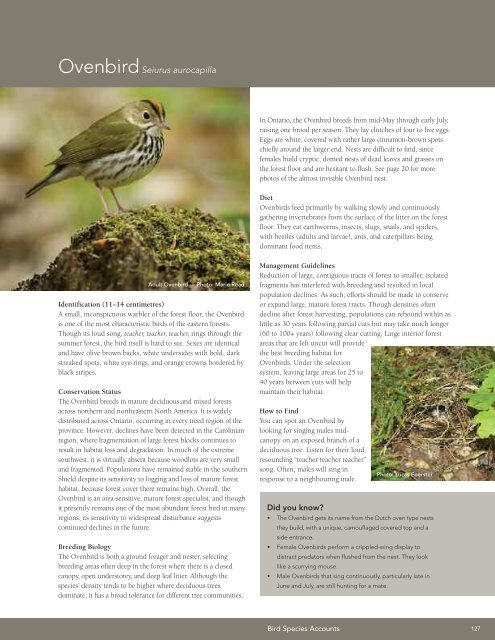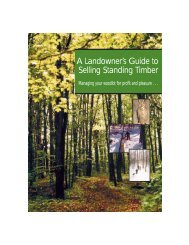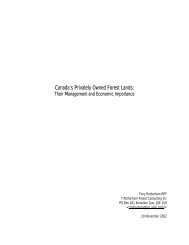A land manager's guide to conserving habitat for forest birds in ...
A land manager's guide to conserving habitat for forest birds in ...
A land manager's guide to conserving habitat for forest birds in ...
You also want an ePaper? Increase the reach of your titles
YUMPU automatically turns print PDFs into web optimized ePapers that Google loves.
Ovenbird Seiurus aurocapilla<br />
In Ontario, the Ovenbird breeds from mid-May through early July,<br />
rais<strong>in</strong>g one brood per season. They lay clutches of four <strong>to</strong> five eggs.<br />
Eggs are white, covered with rather large c<strong>in</strong>namon-brown spots<br />
chiefly around the larger end. Nests are difficult <strong>to</strong> f<strong>in</strong>d, s<strong>in</strong>ce<br />
females build cryptic, domed nests of dead leaves and grasses on<br />
the <strong>for</strong>est floor and are hesitant <strong>to</strong> flush. See page 20 <strong>for</strong> more<br />
pho<strong>to</strong>s of the almost <strong>in</strong>visible Ovenbird nest.<br />
Diet<br />
Oven<strong>birds</strong> feed primarily by walk<strong>in</strong>g slowly and cont<strong>in</strong>uously<br />
gather<strong>in</strong>g <strong>in</strong>vertebrates from the surface of the litter on the <strong>for</strong>est<br />
floor. They eat earthworms, <strong>in</strong>sects, slugs, snails, and spiders,<br />
with beetles (adults and larvae), ants, and caterpillars be<strong>in</strong>g<br />
dom<strong>in</strong>ant food items.<br />
Adult Ovenbird — Pho<strong>to</strong>: Marie Read<br />
Identification (11–14 centimetres)<br />
A small, <strong>in</strong>conspicuous warbler of the <strong>for</strong>est floor, the Ovenbird<br />
is one of the most characteristic <strong>birds</strong> of the eastern <strong>for</strong>ests.<br />
Though its loud song, teacher, teacher, teacher, r<strong>in</strong>gs through the<br />
summer <strong>for</strong>est, the bird itself is hard <strong>to</strong> see. Sexes are identical<br />
and have olive brown backs, white undersides with bold, dark<br />
streaked spots, white eye-r<strong>in</strong>gs, and orange crowns bordered by<br />
black stripes.<br />
Conservation Status<br />
The Ovenbird breeds <strong>in</strong> mature deciduous and mixed <strong>for</strong>ests<br />
across northern and northeastern North America. It is widely<br />
distributed across Ontario, occurr<strong>in</strong>g <strong>in</strong> every treed region of the<br />
prov<strong>in</strong>ce. However, decl<strong>in</strong>es have been detected <strong>in</strong> the Carol<strong>in</strong>ian<br />
region, where fragmentation of large <strong>for</strong>est blocks cont<strong>in</strong>ues <strong>to</strong><br />
result <strong>in</strong> <strong>habitat</strong> loss and degradation. In much of the extreme<br />
southwest, it is virtually absent because woodlots are very small<br />
and fragmented. Populations have rema<strong>in</strong>ed stable <strong>in</strong> the southern<br />
Shield despite its sensitivity <strong>to</strong> logg<strong>in</strong>g and loss of mature <strong>for</strong>est<br />
<strong>habitat</strong>, because <strong>for</strong>est cover there rema<strong>in</strong>s high. Overall, the<br />
Ovenbird is an area-sensitive, mature <strong>for</strong>est specialist, and though<br />
it presently rema<strong>in</strong>s one of the most abundant <strong>for</strong>est bird <strong>in</strong> many<br />
regions, its sensitivity <strong>to</strong> widespread disturbance suggests<br />
cont<strong>in</strong>ued decl<strong>in</strong>es <strong>in</strong> the future.<br />
Breed<strong>in</strong>g Biology<br />
The Ovenbird is both a ground <strong>for</strong>ager and nester, select<strong>in</strong>g<br />
breed<strong>in</strong>g areas often deep <strong>in</strong> the <strong>for</strong>est where there is a closed<br />
canopy, open unders<strong>to</strong>rey, and deep leaf litter. Although the<br />
species’ density tends <strong>to</strong> be higher where deciduous trees<br />
dom<strong>in</strong>ate, it has a broad <strong>to</strong>lerance <strong>for</strong> different tree communities.<br />
Management Guidel<strong>in</strong>es<br />
Reduction of large, contiguous tracts of <strong>for</strong>est <strong>to</strong> smaller, isolated<br />
fragments has <strong>in</strong>terfered with breed<strong>in</strong>g and resulted <strong>in</strong> local<br />
population decl<strong>in</strong>es. As such, ef<strong>for</strong>ts should be made <strong>to</strong> conserve<br />
or expand large, mature <strong>for</strong>est tracts. Though densities often<br />
decl<strong>in</strong>e after <strong>for</strong>est harvest<strong>in</strong>g, populations can rebound with<strong>in</strong> as<br />
little as 30 years follow<strong>in</strong>g partial cuts but may take much longer<br />
(60 <strong>to</strong> 100+ years) follow<strong>in</strong>g clear cutt<strong>in</strong>g. Large <strong>in</strong>terior <strong>for</strong>est<br />
areas that are left uncut will provide<br />
the best breed<strong>in</strong>g <strong>habitat</strong> <strong>for</strong><br />
Oven<strong>birds</strong>. Under the selection<br />
system, leav<strong>in</strong>g large areas <strong>for</strong> 25 <strong>to</strong><br />
40 years between cuts will help<br />
ma<strong>in</strong>ta<strong>in</strong> their <strong>habitat</strong>.<br />
How <strong>to</strong> F<strong>in</strong>d<br />
You can spot an Ovenbird by<br />
look<strong>in</strong>g <strong>for</strong> s<strong>in</strong>g<strong>in</strong>g males midcanopy<br />
on an exposed branch of a<br />
deciduous tree. Listen <strong>for</strong> their loud<br />
resound<strong>in</strong>g “teacher teacher teacher”<br />
song. Often, males will s<strong>in</strong>g <strong>in</strong><br />
response <strong>to</strong> a neighbour<strong>in</strong>g male.<br />
Did you know?<br />
Pho<strong>to</strong>: Lucas Foerster<br />
• The Ovenbird gets its name from the Dutch oven type nests<br />
they build, with a unique, camouflaged covered <strong>to</strong>p and a<br />
side entrance.<br />
• Female Oven<strong>birds</strong> per<strong>for</strong>m a crippled-w<strong>in</strong>g display <strong>to</strong><br />
distract preda<strong>to</strong>rs when flushed from the nest. They look<br />
like a scurry<strong>in</strong>g mouse.<br />
• Male Oven<strong>birds</strong> that s<strong>in</strong>g cont<strong>in</strong>uously, particularly late <strong>in</strong><br />
June and July, are still hunt<strong>in</strong>g <strong>for</strong> a mate.<br />
Bird Species Accounts 127

















